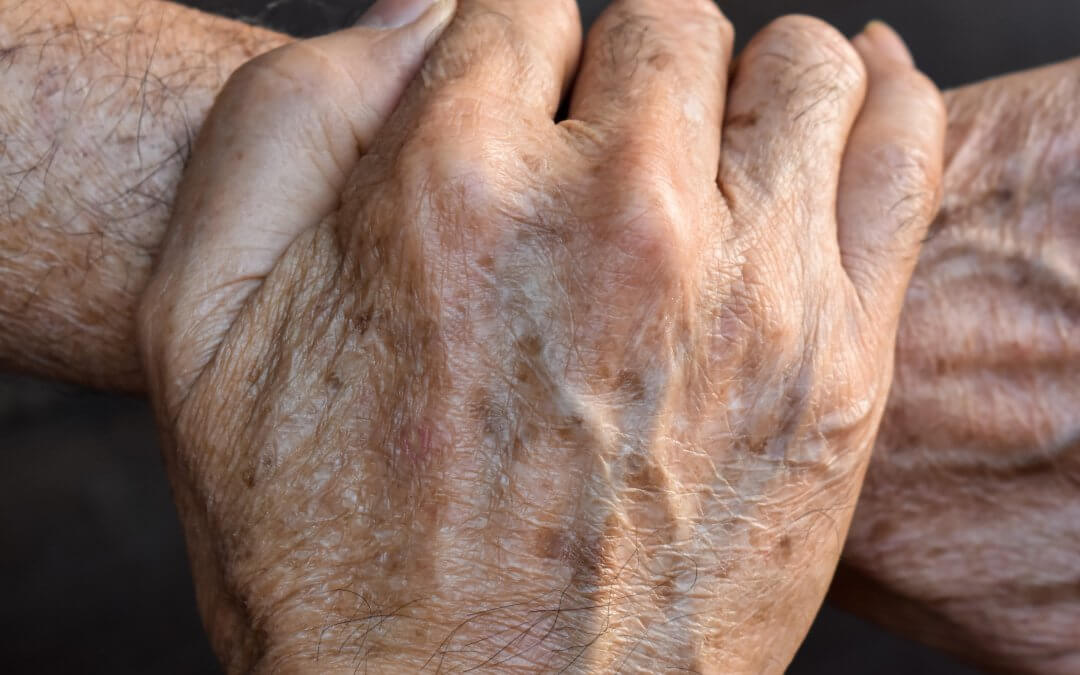A recent study, carried out both in vitro and in vivo on a mouse model, has found that extracellular vesicles derived from adipose (fat) and umbilical cord mesenchymal stem cells could have a regenerative effect on sun-damaged skin.[1]
Sun damage causes and consequences
Unprotected exposure to harmful ultraviolet (UV) rays from the sun damages the DNA in your skin, ageing it prematurely. This is called photoaging, or sun damage, and can take several forms:[2] [3] [4]
- Wrinkles and skin thickening: UV rays break down collagen and elastin, proteins which give your skin its structure and elasticity. As a result, skin becomes thicker and wrinkled over time, beyond what would normally be caused by ageing.
- Sun spots, redness or blotchiness: skin cells produce melanin as a reaction to UV rays, in an attempt to protect against further sun damage. This is the same process that gives you a tan. However, over time, the damaged skin becomes permanently, unevenly pigmented, causing darker patches often called sun spots. This can also take the form of broken blood vessels, causing permanent redness or blotchiness. This happens particularly in areas frequently exposed to the sun, such as the face and hands.
- Skin cancer: too much UV exposure can cause skin cancer. In the UK, overexposure to UV radiation is the cause of 85% of cases of melanoma skin cancers.[5]
What are extracellular vesicles?
Extracellular vesicles are tiny particles which are generated from cells. They can carry important biomolecules, like fats and proteins, to other cells, working as a messenger of sorts.
Because the contents of extracellular vesicles can vary depending on the originating cells, scientists believe they could be of great importance in medicine. They could serve as a prognostic tool to predict the likely course of diseases, as well as help to cure them.[6]
In particular, extracellular vesicles derived from mesenchymal stem cells could inherit their regenerative properties, and have been a recent focus of research for their therapeutic potential.
What did the study find?
In the study, scientists from Peking Union Medical College, Beijing, China, aimed to investigate the effects of extracellular vesicles derived from adipose mesenchymal stem cells (AMSC-EVs) and umbilical cord mesenchymal stem cells (HUMSC-EVs) on photoaging.
In vitro, AMSC-EVs and HUMSC-EVs had positive effects on keratinocytes (cells which make up the outermost layer of the skin) and fibroblasts (cells which make up the connective tissue in the middle layer of the skin) that had been exposed to UV radiation. Treatment with EVs lowered inflammation and reduced the levels at which various biomarkers of senescence (ageing) were present in cells. Moreover, the treatment boosted cell proliferation and migration, properties which make skin cells better able to heal damage. Similar protective and regenerative effects were also observed using an in-vitro, full-thickness model of human skin.
These positive results prompted further analysis in vivo, using nude mice. The mice were randomly split into four groups, keeping one as the control. The other three groups were first exposed to high doses of UV radiation, then treated, respectively, with phosphate-buffered saline (PBS) as a placebo, with AMSC-EVs and with HUMSC-EVs.
All three groups exposed to UV initially developed deep, wide wrinkles. By the end of the observation period, however, the skin of mice treated with EV showed significantly fewer and thinner wrinkles. Skin analysis showed that EV treatment helped the skin recover water content, and reversed the epidermal thickening caused by UV radiation. The treatment also improved collagen and elastin levels and reduced inflammation. Additionally, there were fewer biomarkers of ageing in the skin cells of treated mice.
The benefits of stem cell banking
Both types of EVs studied proved effective in mitigating photoaging. However, the researchers noted that, in the mouse model, the effects of EVs derived from umbilical cord MSCs seemed better, from a therapeutic point of view, than those of EVs derived from fat tissue MSCs. The skin of the mice in the HUMSC-EV treatment group was noticeably less wrinkled. Additionally, the skin’s water content was much closer to that of the mice who had not been exposed to UV radiation at all, as was the epidermal thickness.
Furthermore, the process of collecting fat tissue for therapies is inherently invasive, but must be undergone if patients wish to use autologous (their own) stem cells as a therapeutic source. Conversely, the collection of stem cells from the umbilical cord is a painless, entirely non-invasive process; however, the cord must have been collected immediately after birth, and the cells and tissues cryogenically stored for future use. If this was not done, the only way to access therapies based on umbilical cord stem cells is the use of allogeneic (donor) cords – something which can encounter any number of issues, from lack of availability to incompatibility or rejection.
To find out more about storing your baby’s umbilical cord stem cells, so they will have them ready and waiting rather than needing to seek out alternative stem cell sources should they ever need regenerative therapies, fill in the form below to request your welcome pack.
References
FIND OUT MORE, REQUEST YOUR WELCOME PACK TODAY
All you need to know to make an informed decision.
Provide your contact details to request:
– Complete Welcome Pack and Parent’s Guide
– Information via email
– Contact from our specialist advisors









